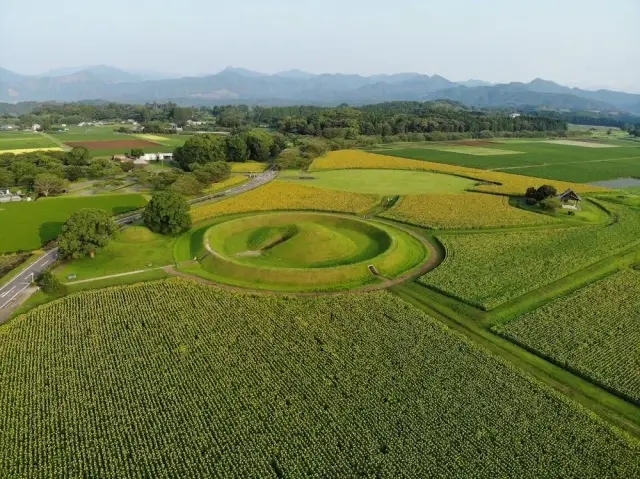https://www.dekitabi.com/itinerary/miyazaki-essential-tour
Miyazaki Prefecture, located on the southeastern coast of Kyushu, is a treasure trove of historical and cultural attractions. This guide will take you on a journey through some of the most significant sites in Miyazaki: the Saitobaru Tumulus Group, Eda Shrine, Heiwadai Park, Miyazaki Shrine, and Miyazaki Hachiman Shrine. Each location offers a unique glimpse into Japan’s rich heritage and the natural beauty of the region.
Saitobaru Tumulus Group

https://www.dekitabi.com/attraction/saitobaru-burial-mounds
The Saitobaru Tumulus Group (西都原古墳群, Saitobaru Kofungun) is one of Japan’s largest and most important ancient burial sites, dating back to the Kofun period (250-538 AD). This site, located in Saito city, encompasses over 300 burial mounds spread across a picturesque landscape. Visitors can explore various types of tumuli, including keyhole-shaped, circular, and square mounds, each serving as the final resting place for ancient rulers and nobility.
The Saitobaru Tumulus Group offers a fascinating insight into early Japanese society and its burial practices. A visit to the Saitobaru Archaeological Museum provides further context with exhibits of artifacts unearthed from the mounds, including pottery, weapons, and jewelry. The museum also offers interactive displays and detailed information about the excavation processes.
Eda Shrine

https://www.dekitabi.com/attraction/eda-shrine-miyazaki
Eda Shrine (江田神社, Eda Jinja) is a serene Shinto shrine nestled in the lush forests of Miyazaki. This sacred site is dedicated to Izanagi and Izanami, the deities of creation in Japanese mythology. The shrine’s tranquil atmosphere and beautiful natural surroundings make it a perfect spot for contemplation and spiritual reflection.
One of the highlights of Eda Shrine is its ancient camphor tree, which is said to be over 1,000 years old. This majestic tree, with its sprawling branches and impressive girth, is considered sacred and is a symbol of longevity and strength. Visitors can also enjoy a peaceful stroll along the shrine’s scenic paths, which are particularly beautiful during the cherry blossom season in spring.
Heiwadai Park

https://www.dekitabi.com/attraction/miyazaki-heiwadai-park
Heiwadai Park (平和台公園, Heiwadai Kōen) is a sprawling park in Miyazaki city that offers a blend of natural beauty and historical significance. The park’s centerpiece is the Heiwadai Tower, also known as the Peace Tower, which was erected in 1940 to commemorate the 2,600th anniversary of the founding of Japan. The tower stands as a symbol of peace and unity and provides panoramic views of the surrounding area.
In addition to the Peace Tower, Heiwadai Park is home to the Haniwa Garden, where visitors can see over 400 replicas of ancient Haniwa clay figures. These figures, which date back to the Kofun period, depict various aspects of early Japanese life, including warriors, dancers, and animals. The park’s extensive walking trails, vibrant seasonal flowers, and peaceful picnic areas make it a popular destination for both locals and tourists.
Miyazaki Shrine

https://www.dekitabi.com/attraction/miyazaki-jingu
Miyazaki Shrine (宮崎神宮, Miyazaki Jingū) is one of the most important Shinto shrines in Miyazaki Prefecture. Dedicated to Emperor Jimmu, the legendary first emperor of Japan, the shrine has a deep historical and cultural significance. The shrine’s grounds are expansive and beautifully maintained, featuring ancient trees, tranquil ponds, and traditional architecture.
Visitors to Miyazaki Shrine can participate in various Shinto rituals and festivals held throughout the year. One of the most notable events is the annual Miyazaki Jingu Aki Matsuri (Autumn Festival), which features traditional music, dance, and a procession of mikoshi (portable shrines). The serene atmosphere and spiritual ambiance of the shrine make it a must-visit destination for those seeking to connect with Japan’s rich cultural heritage.
Miyazaki Hachiman Shrine

https://www.dekitabi.com/attraction/miyazakihachimangu
Miyazaki Hachiman Shrine (宮崎八幡宮, Miyazaki Hachimangū) is another significant Shinto shrine in Miyazaki. Dedicated to Hachiman, the god of war and the divine protector of Japan, the shrine has a long history dating back to the Heian period (794-1185). The shrine’s architecture is a blend of traditional Japanese styles, featuring a main hall, a prayer hall, and a distinctive torii gate.
The shrine is particularly famous for its annual Reitaisai (grand festival), which includes various traditional performances, martial arts demonstrations, and a grand procession. The festival is a vibrant celebration of Japanese culture and offers visitors a unique opportunity to experience the local traditions and customs.
Exploring Miyazaki: Practical Tips
When visiting these historical and cultural sites in Miyazaki, it is essential to plan your trip to maximize your experience. Here are some practical tips to help you make the most of your visit:
- Transportation: Miyazaki is well-connected by public transportation, including trains and buses. Renting a car is also a convenient option for exploring the region at your own pace.
- Best Time to Visit: The best time to visit Miyazaki is during spring (March to May) and autumn (September to November) when the weather is pleasant, and the natural scenery is at its most beautiful.
- Local Cuisine: Don’t miss the opportunity to try Miyazaki’s local delicacies, such as Miyazaki beef, chicken nanban (fried chicken with a tangy sauce), and mangoes.
- Respect Local Customs: When visiting shrines and temples, it is essential to respect local customs and etiquette. This includes bowing before entering the shrine, washing your hands at the purification fountain, and being quiet and respectful during your visit.
Conclusion
Miyazaki’s Saitobaru Tumulus Group, Eda Shrine, Heiwadai Park, Miyazaki Shrine, and Miyazaki Hachiman Shrine offer a rich tapestry of history, culture, and natural beauty. Each site provides a unique window into Japan’s ancient past and spiritual traditions. Whether you are a history enthusiast, a nature lover, or simply seeking a peaceful retreat, these destinations in Miyazaki Prefecture promise an unforgettable experience.


Leave a Reply